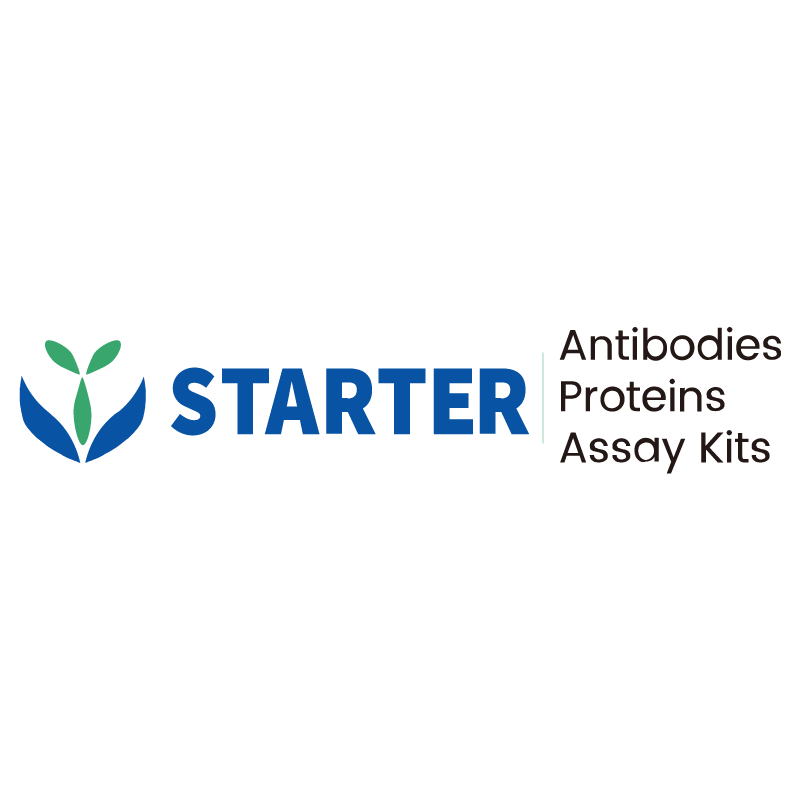WB result of AAT Recombinant Rabbit mAb
Primary antibody: AAT Recombinant Rabbit mAb at 1/1000 dilution
Lane 1: human plasma lysate 5 µg
Lane 2: human serum lysate 5 µg
Secondary antibody: Goat Anti-rabbit IgG, (H+L), HRP conjugated at 1/10000 dilution
Predicted MW: 47 kDa
Observed MW: 60 kDa
Product Details
Product Details
Product Specification
| Host | Rabbit |
| Antigen | AAT |
| Synonyms | Alpha-1-antitrypsin, Alpha-1 protease inhibitor, Alpha-1-antiproteinase, Serpin A1, SERPINA1, PI |
| Immunogen | Recombinant Protein |
| Location | Secreted |
| Accession | P01009 |
| Clone Number | S-943-37 |
| Antibody Type | Recombinant mAb |
| Isotype | IgG |
| Application | WB, IHC-P, ICC, ICFCM, IP |
| Reactivity | Hu |
| Purification | Protein A |
| Concentration | 0.5 mg/ml |
| Conjugation | Unconjugated |
| Physical Appearance | Liquid |
| Storage Buffer | PBS, 40% Glycerol, 0.05% BSA, 0.03% Proclin 300 |
| Stability & Storage | 12 months from date of receipt / reconstitution, -20 °C as supplied |
Dilution
| application | dilution | species |
| WB | 1:1000 | null |
| IP | 1:50 | null |
| IHC-P | 1:2000 | null |
| ICC | 1:500 | null |
| ICFCM | 1:50 | null |
Background
Alpha-1 antitrypsin (AAT) is a prominent serine protease inhibitor and an acute phase protein that plays a crucial role in the human body. It is primarily synthesized in the liver and functions to neutralize proteases, particularly neutrophil elastase, thereby protecting the lungs from damage. A deficiency in AAT can lead to several diseases, notably emphysema and liver cirrhosis, due to the accumulation of unneutralized proteases in the lungs and liver, respectively. Clinical manifestations of AAT deficiency often include symptoms such as chronic cough, shortness of breath, and liver enlargement. Diagnosis typically involves measuring plasma AAT levels, phenotyping, and genetic testing to identify specific mutations. Some patients with AAT deficiency may benefit from augmentation therapy, which involves the intravenous administration of AAT to increase its levels in the bloodstream and reduce the impact of protease activity. Recent research has highlighted AAT's broader immunomodulatory role, with studies focusing on its interactions with lipids and other proteins, mainly through electrostatic, glycan, or hydrophobic binding sites. AAT's potential therapeutic applications extend beyond the treatment of AAT deficiency, with research suggesting its use in managing disorders associated with chronic immune responses.
Picture
Picture
Western Blot
FC
Flow cytometric analysis of 4% PFA fixed 90% methanol permeabilized HepG2 (Human hepatocellular carcinoma epithelial cell) labelling AAT antibody at 1/50 dilution (1 μg)/ (Red) compared with a Rabbit monoclonal IgG (Black) isotype control and an unlabelled control (cells without incubation with primary antibody and secondary antibody) (Blue). Goat Anti - Rabbit IgG Alexa Fluor® 488 was used as the secondary antibody.
IP
AAT Rabbit mAb at 1/50 dilution (1 µg) immunoprecipitating AAT in 0.4 mg human serum lysate.
Western blot was performed on the immunoprecipitate using AAT Rabbit mAb at 1/1000 dilution.
Secondary antibody (HRP) for IP was used at 1/1000 dilution.
Lane 1: human serum lysate 20 µg (Input)
Lane 2: AAT Rabbit mAb IP in human serum lysate
Lane 3: Rabbit monoclonal IgG IP in human serum lysate
Predicted MW: 47 kDa
Observed MW: 60 kDa
Immunohistochemistry
IHC shows positive staining in paraffin-embedded human liver. Anti-AAT antibody was used at 1/2000 dilution, followed by a HRP Polymer for Mouse & Rabbit IgG (ready to use). Counterstained with hematoxylin. Heat mediated antigen retrieval with Tris/EDTA buffer pH9.0 was performed before commencing with IHC staining protocol.
IHC shows positive staining in paraffin-embedded human kidney. Anti-AAT antibody was used at 1/2000 dilution, followed by a HRP Polymer for Mouse & Rabbit IgG (ready to use). Counterstained with hematoxylin. Heat mediated antigen retrieval with Tris/EDTA buffer pH9.0 was performed before commencing with IHC staining protocol.
IHC shows positive staining in paraffin-embedded human placenta. Anti-AAT antibody was used at 1/2000 dilution, followed by a HRP Polymer for Mouse & Rabbit IgG (ready to use). Counterstained with hematoxylin. Heat mediated antigen retrieval with Tris/EDTA buffer pH9.0 was performed before commencing with IHC staining protocol.
IHC shows positive staining in paraffin-embedded human hepatocellular. Anti-AAT antibody was used at 1/2000 dilution, followed by a HRP Polymer for Mouse & Rabbit IgG (ready to use). Counterstained with hematoxylin. Heat mediated antigen retrieval with Tris/EDTA buffer pH9.0 was performed before commencing with IHC staining protocol.
Immunocytochemistry
ICC shows positive staining in HepG2 cells. Anti-AAT antibody was used at 1/500 dilution (Green) and incubated overnight at 4°C. Goat polyclonal Antibody to Rabbit IgG - H&L (Alexa Fluor® 488) was used as secondary antibody at 1/1000 dilution. The cells were fixed with 100% ice-cold methanol and permeabilized with 0.1% PBS-Triton X-100. Nuclei were counterstained with DAPI (Blue). Counterstain with tubulin (Red).


